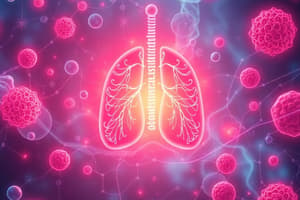Podcast
Questions and Answers
Which process produces water as a byproduct?
Which process produces water as a byproduct?
- Anaerobic respiration
- Electron transport chain (correct)
- Fermentation
- Glycolysis
What is the purpose of using barium hydroxide in demonstrating CO₂ release?
What is the purpose of using barium hydroxide in demonstrating CO₂ release?
- It enhances aerobic respiration
- It forms a precipitate with CO₂ (correct)
- It produces a color change with oxygen
- It acts as an acid to neutralize CO₂
What percentage of energy from glucose breakdown is captured as ATP during aerobic respiration?
What percentage of energy from glucose breakdown is captured as ATP during aerobic respiration?
- 100%
- 20%
- 60%
- 40% (correct)
What type of enzyme is involved in transferring hydrogen atoms during aerobic respiration?
What type of enzyme is involved in transferring hydrogen atoms during aerobic respiration?
What happens to methylene blue when it is used as a proton acceptor by yeast?
What happens to methylene blue when it is used as a proton acceptor by yeast?
What is the primary function of cellular aerobic respiration?
What is the primary function of cellular aerobic respiration?
Where does glycolysis occur in the cell?
Where does glycolysis occur in the cell?
Which product is formed during pyruvate oxidation?
Which product is formed during pyruvate oxidation?
What is the main purpose of the Electron Transport Chain (ETC)?
What is the main purpose of the Electron Transport Chain (ETC)?
How many ATP molecules are produced during the Citric Acid Cycle for each glucose molecule?
How many ATP molecules are produced during the Citric Acid Cycle for each glucose molecule?
What role does oxygen play in aerobic respiration?
What role does oxygen play in aerobic respiration?
What is the total ATP yield from one glucose molecule under ideal conditions in eukaryotic cells?
What is the total ATP yield from one glucose molecule under ideal conditions in eukaryotic cells?
Which of the following processes is anaerobic?
Which of the following processes is anaerobic?
What role does heat play in aerobic respiration?
What role does heat play in aerobic respiration?
What does the formation of barium carbonate (BaCO3) in the presence of barium hydroxide (Ba(OH)₂) indicate?
What does the formation of barium carbonate (BaCO3) in the presence of barium hydroxide (Ba(OH)₂) indicate?
What can be inferred about the efficiency of glucose utilization in aerobic respiration?
What can be inferred about the efficiency of glucose utilization in aerobic respiration?
What is the primary role of dehydrogenases in aerobic respiration?
What is the primary role of dehydrogenases in aerobic respiration?
What happens to methylene blue when it acts as a proton acceptor in yeast?
What happens to methylene blue when it acts as a proton acceptor in yeast?
What is the primary location of glycolysis within the cell?
What is the primary location of glycolysis within the cell?
Which metabolic process occurs after glycolysis?
Which metabolic process occurs after glycolysis?
What is the primary output of the Citric Acid Cycle for every glucose molecule processed?
What is the primary output of the Citric Acid Cycle for every glucose molecule processed?
What is the role of oxygen in the Electron Transport Chain?
What is the role of oxygen in the Electron Transport Chain?
At which stage of aerobic respiration is carbon dioxide released?
At which stage of aerobic respiration is carbon dioxide released?
What is the net gain of ATP molecules produced during glycolysis?
What is the net gain of ATP molecules produced during glycolysis?
Which stage of aerobic respiration does NOT require oxygen?
Which stage of aerobic respiration does NOT require oxygen?
How many ATP molecules are typically synthesized through the Electron Transport Chain?
How many ATP molecules are typically synthesized through the Electron Transport Chain?
Flashcards
Cellular Respiration
Cellular Respiration
A metabolic process converting nutrient energy (like glucose) into ATP for cell functions.
Glycolysis Location
Glycolysis Location
The cytoplasm of the cell
Glycolysis Product
Glycolysis Product
2 ATP, 2 NADH, and 2 pyruvate molecules.
Pyruvate Oxidation Location
Pyruvate Oxidation Location
Signup and view all the flashcards
Pyruvate Oxidation Product
Pyruvate Oxidation Product
Signup and view all the flashcards
Krebs Cycle Product
Krebs Cycle Product
Signup and view all the flashcards
Electron Transport Chain (ETC) Location
Electron Transport Chain (ETC) Location
Signup and view all the flashcards
ETC and Oxidative Phosphorylation Product
ETC and Oxidative Phosphorylation Product
Signup and view all the flashcards
Aerobic Respiration Water Formation
Aerobic Respiration Water Formation
Signup and view all the flashcards
Aerobic Respiration CO2 Release
Aerobic Respiration CO2 Release
Signup and view all the flashcards
Aerobic Respiration Heat Production
Aerobic Respiration Heat Production
Signup and view all the flashcards
Dehydrogenase Enzyme Function
Dehydrogenase Enzyme Function
Signup and view all the flashcards
Barium Hydroxide CO2 Detection
Barium Hydroxide CO2 Detection
Signup and view all the flashcards
What happens to hydrogen atoms in dehydrogenase activity?
What happens to hydrogen atoms in dehydrogenase activity?
Signup and view all the flashcards
How does barium hydroxide demonstrate CO₂ release?
How does barium hydroxide demonstrate CO₂ release?
Signup and view all the flashcards
What byproduct is formed during the ETC?
What byproduct is formed during the ETC?
Signup and view all the flashcards
Why does aerobic respiration generate heat?
Why does aerobic respiration generate heat?
Signup and view all the flashcards
What is the role of methylene blue in yeast respiration?
What is the role of methylene blue in yeast respiration?
Signup and view all the flashcards
What's the primary function of cellular respiration?
What's the primary function of cellular respiration?
Signup and view all the flashcards
Where does glycolysis take place?
Where does glycolysis take place?
Signup and view all the flashcards
Pyruvate Oxidation: Where does it happen?
Pyruvate Oxidation: Where does it happen?
Signup and view all the flashcards
What key molecule is produced during pyruvate oxidation?
What key molecule is produced during pyruvate oxidation?
Signup and view all the flashcards
Krebs Cycle: What's its main goal?
Krebs Cycle: What's its main goal?
Signup and view all the flashcards
Electron Transport Chain (ETC): Where does it occur?
Electron Transport Chain (ETC): Where does it occur?
Signup and view all the flashcards
What's the role of oxygen in ETC?
What's the role of oxygen in ETC?
Signup and view all the flashcards
What is the main product of cellular respiration?
What is the main product of cellular respiration?
Signup and view all the flashcards
Study Notes
Cellular Aerobic Respiration
- Aerobic respiration is a metabolic process where cells convert biochemical energy from nutrients (like glucose) into adenosine triphosphate (ATP).
- This process requires oxygen and occurs in the mitochondria of eukaryotic cells.
- Aerobic respiration is vital for producing the majority of ATP organisms need to survive.
Stages of Aerobic Respiration
1. Glycolysis
- Location: Cytoplasm of the cell.
- Process: Glucose (a six-carbon molecule) breaks down into two pyruvate molecules (three carbons each).
- Products: 2 ATP (net), 2 NADH, and 2 pyruvate molecules.
- Oxygen Requirement: Anaerobic (doesn't require oxygen).
- Glycolysis is the initial step for both aerobic and anaerobic respiration.
2. Pyruvate Oxidation
- Location: Mitochondrial matrix (in eukaryotes).
- Process: Each pyruvate is converted into acetyl-CoA, releasing one carbon dioxide molecule per pyruvate.
- Products: 2 CO₂, 2 NADH, and 2 acetyl-CoA (one from each pyruvate).
- Oxygen Requirement: Aerobic (requires oxygen).
3. Citric Acid Cycle (Krebs Cycle)
- Location: Mitochondrial matrix.
- Process: Acetyl-CoA combines with oxaloacetate to form citrate, undergoing reactions to produce energy-rich molecules.
- Products: 2 ATP, 6 NADH, 2 FADH₂, and 4 CO₂ (for every glucose molecule).
- Oxygen Requirement: Aerobic (requires oxygen).
4. Electron Transport Chain (ETC) and Oxidative Phosphorylation
- Location: Inner mitochondrial membrane.
- Process: Electrons from NADH and FADH₂ pass through protein complexes, releasing energy used to pump protons across the membrane, creating a proton gradient for ATP synthesis.
- Products: Around 32-34 ATP molecules and water (from oxygen accepting electrons and protons).
- Oxygen Requirement: Requires oxygen as the final electron acceptor.
Summary of ATP Yield
- Total ATP Production: Approximately 36-38 ATP per glucose molecule under ideal conditions in eukaryotic cells.
Practical Part
1. Water Condensation by Aerobic Respiration
- Water is a byproduct of aerobic respiration, produced during the electron transport chain (ETC) and oxidative phosphorylation.
- Observing condensed water on a cold surface indicates water is being released.
2. CO₂ Liberation by Aerobic Respiration
- Barium hydroxide (Ba(OH)₂) reacts with carbon dioxide (CO₂) to form a white precipitate (BaCO₃) and water.
- The presence of this precipitate verifies the presence of CO₂ released during aerobic respiration.
3. Heat Produced by Aerobic Respiration
- Heat is a byproduct of energy transformations during glucose breakdown and ATP formation.
- Glucose breakdown is an exergonic reaction releasing energy, only partially captured as ATP (about 40% of the total energy).
4. Dehydrogenase Activity
- Dehydrogenases are enzymes that catalyze oxidation reactions, typically transferring hydrogen atoms from glucose to an electron acceptor (like NAD⁺).
- Using methylene blue as a proton acceptor, a color change (from blue to colorless) indicates a successful dehydrogenase-catalyzed reaction.
Studying That Suits You
Use AI to generate personalized quizzes and flashcards to suit your learning preferences.




